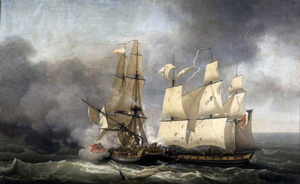HMS Ambuscade (1773)
 Ambuscade fighting Bayonnaise, by Jean-François Hue
| |
| History | |
|---|---|
| Name | HMS Ambuscade |
| Ordered | 25 December 1770 |
| Builder | Adams & Barnard, Deptford |
| Laid down | April 1771 |
| Launched | 17 September 1773 |
| Commissioned | January 1776 |
| Captured | 14 December 1798 |
| Name | Embuscade |
| Acquired | 14 December 1798 |
| Captured | 28 May 1803 |
| Name | HMS Ambuscade |
| Acquired | 28 May 1803 |
| Fate | Broken up in 1810 |
| General characteristics as built | |
| Class and type | 32-gun fifth-rate Amazon-class frigate (1773) frigate |
| Length |
|
| Beam | 35 ft 1.75 in (10.7125 m) |
| Draught |
|
| Depth of hold | 12 ft 2 in (3.71 m) |
| Sail plan | Full-rigged ship |
| Complement | 220 |
| Armament |
|
HMS Ambuscade was a 32-gun fifth-rate frigate of the Royal Navy, built in the Grove Street shipyard of Adams & Barnard at Depford in 1773. The French captured her in 1798 but the British recaptured her in 1803. She was broken up in 1810.
American Revolution[]
On 19 May, 1778 she recaptured brig Mary.[1] On 31 May, 1778 she captured American brig "Charming Sally" near .[2]
On 22 June 1779, after a short action, Ambuscade captured the French brig Hélene, which was the former Royal Navy 14-gun sloop . The Royal Navy took her back into service under her original name.[3][4] Six days later Ambuscade captured the French privateer Prince de Montbray.[4] The privateer was possibly out of Granville and under the command of Captain Boisnard-Maisonneuve.[5]
captured the "private man of war" Américaine on 26 January 1781. She was armed with 32 guns and carried a crew of 245. HMS Ambuscade shared in the proceeds of the capture.[Note 1]
French Revolutionary Wars[]
In August 1798 Ambuscade, commanded by Captain Henry Jenkins,[7] with Stag and the hired armed cutter Nimrod captured the chasse maree Francine .[8] Then Ambuscade shared with Phaeton and Stag, in the capture on 20 November of the Hirondelle.[9]


On 13 December 1798, Ambuscade captured a French merchantman, Faucon, with a cargo of sugar and coffee bound for Bordeaux.[10]
Disaster struck the following day. Ambuscade was blockading Rochefort, when the smaller French corvette Bayonnaise captured her at the action of 14 December 1798. The court martial exonerated Captain Henry Jenkins of Ambuscade, though a good case could be made that he exhibited poor leadership and ship handling.[11] The French brought her into service as Embuscade.
Napoleonic Wars[]
On 28 May 1803, HMS Victory recaptured her. She had a crew of 187 men under the command of capitaine de vaisseau Fradin, and was 30 days out of Cap Francais, bound for Rochefort.[12] The Royal Navy took her back into service as Ambuscade.
In March 1805, she was attached to Sir James Craig's military expedition to Italy. Along with Dragon, Craig's flagship, and Lively, Ambuscade escorted a fleet of transports to Malta.[13]
On 4 March 1807, Ambuscade captured the ship Istria. Unité, Melpomene, and Weazel (or Weazle) were in company and shared in the prize money.[14]
Fate[]
Ambuscade was broken up in 1810.

Notes, citations, and references[]
Notes
Citations
- ^ "NAVAL DOCUMENTS OF The American Revolution" (PDF). history.navy.mil. Retrieved 24 October 2021.
- ^ "NAVAL DOCUMENTS OF The American Revolution" (PDF). history.navy.mil. Retrieved 7 November 2021.
- ^ Demerliac (1996), p. 71, #448.
- ^ a b "No. 12044". The London Gazette. 28 December 1779. p. 2.
- ^ Demerliac (1996), p. 184, #1810.
- ^ "No. 12203". The London Gazette. 30 June 1781. p. 2.
- ^ Wareham (2001), p. 137.
- ^ "No. 15113". The London Gazette. 5 March 1799. p. 220.
- ^ "No. 15149". The London Gazette. 18 June 1799. p. 617.
- ^ Correspondence, Lord Bridport to Evan Nepean, 22 December 1798. Cited in Naval Chronicle Vol. 1, 1799, p. 77
- ^ Hepper (1994), p. 89.
- ^ "No. 15608". The London Gazette. 6 August 1803. p. 986.
- ^ von Pivka, Navies.
- ^ "No. 16529". The London Gazette. 8 October 1811. p. 1976.
References
- Demerliac, Alain (1996) La Marine De Louis XVI: Nomenclature Des Navires Français De 1774 À 1792. (Nice: Éditions OMEGA). ISBN 2-906381-23-3
- Hepper, David J. (1994). British Warship Losses in the Age of Sail, 1650-1859. Rotherfield: Jean Boudriot. ISBN 0-948864-30-3.
- "The Monthly Register of Naval Events". The Naval Chronicle. United Kingdom: Cambridge University Press (reprint). 1. 2010. OCLC 700504496.
- Otto von Pivka (1980). Navies of the Napoleonic Era. David & Charles. ISBN 0-7153-7767-1.
- Wareham, Tom (2001) The star captains: frigate command in the Napoleonic Wars. (Annapolis, Md. Naval Inst. Press). ISBN 978-1-55750-871-3
- Michael Phillips' ships of the old Navy
- Naval history of Great Britain, by William James
External links[]
 Media related to HMS Ambuscade (ship, 1773) at Wikimedia Commons
Media related to HMS Ambuscade (ship, 1773) at Wikimedia Commons
- Frigates of the Royal Navy
- War of 1812 ships of the United Kingdom
- Age of Sail frigates of France
- Ships built in Deptford
- 1773 ships
- Frigates of the French Navy
- Captured ships